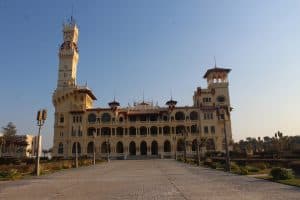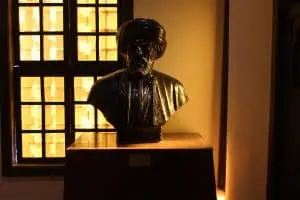Decoding the Nazca Lines: Unravelling the Secrets of Peru’s Geoglyphs

Updated On: April 24, 2024 by Raghda Elsabbagh
The Nazca Lines, etched into the arid soil of the Peruvian desert, have piqued the curiosity of scholars and adventurers for decades. These monumental geoglyphs cover an area of nearly 500 square kilometres and depict various shapes and figures, from animals to geometric patterns. Researchers propose that they were created between 500 BCE and 500 CE, which speaks to the advanced nature of the Nazca culture. Thanks to the dry climate of the Nazca Desert, these lines have been remarkably well-preserved, allowing us to study and admire them centuries later.

Our fascination with the Nazca Lines is not solely due to their size or their survival through time; it is their mysterious origins and purposes that captivate us. While their visibility from the air suggests they could have served some astronomical or navigational purpose, other theories suggest religious or cultural significance. Each new study brings us closer to understanding the Nazca people and the functions of these enigmatic symbols. Modern technology, like satellite imaging, plays a pivotal role in uncovering the secrets the desert has kept for millennia, offering clues that help us decode archaeological mysteries such as this one.
Table of Contents
The Landscape of Nazca
In the Nazca Desert of Peru, a barren expanse reveals the extraordinary enigma of the Nazca Lines. We find ourselves approximately 400 kilometres south of Lima amidst one of the most arid plateaus on the South American continent. The vastness of this Peruvian desert is home to some of the most intriguing archaeological wonders of the world.
The terrain here is overwhelmingly desolate, yet paradoxically, it’s this very landscape of dry, windless, and stable climate that has preserved the Nazca Lines for centuries. The geoglyphs, created by the Nazca people, are etched across an area of nearly 1,000 square kilometres. The foothills of the Andes ring this canvas of desert plains and overlooks the deep blue waters of the Paracas Bay.
The Nazca Desert isn’t just uniform sands; it comprises a palette of dust, rocks, and gravel, creating a natural contrast that emphasises the lines. Here, the geoglyphs, which range from simple lines to elaborate figures, become visible. These designs are best appreciated from an aerial view, where the scale and intricacy of each geoglyph truly come into focus.
Our exploration reveals how the landscape itself is a critical component of the Lines’ mystery. The relative isolation and pristine condition of the area have allowed these anthropogenic features to become a focal point for both admiration and study. They are a testament to the adaptability and creativity of the Nazca culture in such a stark environment. Evidently, the transcendental beauty of this barren and ancient landscape beckons us, posing silent questions about the past.
Origins and Discoveries
The Nazca Lines represent one of history’s most fascinating enigmas, consisting of hundreds of geoglyphs etched into the Peruvian desert. Created by the ancient Nazca people, these monumental drawings have baffled scientists and archaeologists for years. The lines date back to between 500 BCE and 500 CE, with the earliest creations attributed to the Paracas culture.
We first gained scholarly attention for these geoglyphs through the efforts of Paul Kosok, an American historian, and Toribio Mejia Xesspe, a Peruvian archaeologist. It was Kosok who, upon witnessing the lines during the winter solstice, suggested they might hold astronomical significance.
Discoveries over the years have revealed that the Nazca Lines cover an area of nearly 500 square kilometres. These include simple lines, geometric patterns, and intricate depictions of animals and plants. Despite their ancient origins, the aridity of the desert has incredibly preserved the lines.
Key Findings:
- The Nazca Lines are predominantly geometric forms and figures such as plants and animals.
- Evidence of religious offerings has emerged near the lines.
- Archaeologists like Paul Kosok and Toribio Mejia Xesspe have studied the lines for their archaeological and cultural significance.
The precise function of the Nazca Lines remains a topic of debate, but they stand as a testament to the ingenuity of ancient civilisations. Their presence continues to draw interest, leading to ongoing archaeological investigations into this historic and cultural legacy.
Unravelling the Purpose
The purpose behind the Nazca Lines, a series of vast geoglyphs etched into the Peruvian desert, has long eluded scholars. We consider various interpretations that link these lines to the ancient Nazca’s cultural and religious beliefs.
Astronomical Calendar: It’s posited that the lines functioned as an astronomical calendar, aiding in the tracking of celestial events. The lines align with certain astronomical phenomena, such as the winter solstice, supporting this theory.
Religious Rituals: The possibility that the lines played a role in rituals dedicated to the gods for fertility and rain is supported by their proximity to Cahuachi, a major ceremonial centre. This gives credence to a religious and ritualistic interpretation of their purpose.
Irrigation and Water: Others speculate that the geoglyphs are connected to water, a precious resource in the arid landscape, indicating irrigation systems or guiding pilgrimage routes to sources of water.
Fertility: The depiction of animals and plants could signify a focus on fertility and the beliefs surrounding the regeneration of life. By walking along these lines, the Nazca may have performed a pilgrimage that underscored their dependence on nature’s cycles.
Calendrical Purpose: Considering the calendrical purpose, evidence suggests that the lines might have been key to an agricultural calendar, directing the sowing and harvesting of crops.
It’s crucial to recognise that our understanding evolves as research continues. While direct evidence may be scarce, the integration of astronomical alignment, religious significance, and practical applications in irrigation and fertility remains a compelling composite of the Nazca Lines’ purpose.
Studying the Geoglyphs
In unravelling the mysteries of Peru’s Nazca Lines, a variety of techniques are utilised to study the expansive collection of geoglyphs. These ancient designs are attributed to the Nazca culture and are thought to date back to between 500 BCE and 500 CE.
Methods: Our approach involves on-site surveys, aerial photography, and, more recently, advanced technology such as satellite imagery and AI-assisted pattern recognition. The goal is to preserve the geoglyphs from further erosion and human interference while seeking new insights into their purpose.
Findings: Through careful study, we’ve documented an array of figures, including animals such as spiders, birds, whales, and llamas. Additionally, our research has identified humanoid figures, dogs, and an intricate array of geometric designs, including triangles.
Symbolism: Some theorise that these lines represent constellations or have astronomical significance due to alignments with celestial events. Another perspective links the geoglyphs to water, a vital resource in the arid environment where they are found.
Artistic Comparisons: When we examine ancient pottery from the region, notable similarities in artistic motifs reaffirm connections between the geoglyphs and the broader Nazca culture. This parallel extends our understanding of their artistic heritage.
Future Research: As we continue to uncover new designs, such as those recently identified using AI technology, our grasp of the geoglyphs’ full extent and meaning deepens. Additional research may provide further illumination on these enigmatic creations, preserving their legacy for future generations to study and appreciate.
Significance of Flora and Fauna

When we discuss the Nazca Lines, it’s impossible to ignore the representations of various plants and animals that adorn this arid Peruvian plain. Among these are several biomorphs — stylised figures of living creatures. The monkey, with its coiled tail, is particularly famous, symbolising perhaps the Nazca people’s resourcefulness and adaptation to their environment.
Similarly, the depiction of the cat could reflect the importance of this animal in their cultural mythology or daily life. The Nazca Lines include numerous figures of local animals and plants, which further underline the close relationship between the Nazca culture and its natural surroundings.
The spider, another biomorph, is notable for its accuracy in portraying the arachnid’s form, with suggestions that it might be related to rain and fertility due to its connection to water in Nazca mythology. Meanwhile, the hummingbird characterises agility and vitality with its life-like dimensions, possibly held as a symbol of life or rebirth.
We must consider how these figures might have had a ritualistic or symbolic role, acting as offerings or prayers to deities for fertility, water, or successful crops. Trees and flowers, less prevalent than the animal geoglyphs, are nonetheless present and potentially served as markers or simply reflected the Nazca’s surroundings and the resources they provided.
It’s crucial not to overstate their significance, yet we understand that these figures were significant enough to be etched on such a colossal scale, ensuring their visibility to the deities above or, as some theories suggest, to participants in religious ceremonies. The precise reasons these plants and animals were so prominently featured among the Nazca etchings remain elusive and are a subject of ongoing research and fascination.
Techniques and Tools
The Nazca Lines stand as a testament to the ingenuity of the ancient Nazca civilization. Unravelling the tools and techniques they employed requires us to consider the simplicity yet effectiveness of their methods.
Firstly, the lines were crafted on the high desert plateau where reddish-brown, iron oxide-coated pebbles dominate the landscape. Through careful removal of these pebbles, the lighter-coloured soil beneath was revealed, creating stark contrast in hues. Our examination reveals that this was a meticulous process, removing just the top layer without disturbing the earth below too deeply.
Simple surveying tools were used to create straight lines and geometric shapes. Stakes were placed into the ground, likely tied with ropes, to serve as guidelines. There is evidence to suggest that even the most substantial figures were plotted with precision, adhering to these rudimentary yet effective outlines.
Pebbles played a dual role; while their removal was crucial for line creation, they also played a part in the preservation process. The lack of iron oxide on the exposed ground may have helped protect these designs from the natural elements by reducing wind erosion, contributing to their longevity.
Here is an overview of the primary tools and methods used by the Nazca:
- Tools Used:
- Wooden sticks
- Fibrous ropes
- Bone or wooden scrapers
- Techniques:
- Stake placement for outlining designs
- Scraping away iron oxide-coated pebbles
- Shallow excavation of the top layer
Given the absence of advanced technology, it is remarkable how the Nazca transformed their arid environment into an artistic canvas on such a grand scale. In approaching these lines, we must appreciate the blend of resourcefulness and environmental understanding possessed by this ancient culture.
Cultural and Religious Practices

In our examination of the Nazca Lines, worship and reverence towards deities are prominent. The vast geoglyphs etched into the Peruvian desert floor suggest their significant role in rituals. Scholars theorise that these ceremonial lines may have been created as part of Nazca culture’s religious practices, potentially used to communicate with gods or as pathways in religious processions.
- Deities: The Nazca people likely venerated various gods associated with the natural world.
- Ceremonies: It is possible that the lines were integral to Nazca ceremonies, especially those involving agriculture and fertility.
The imagery of the geoglyphs, depicting a range of stylised animals and plants, underscores their cultural importance. We see evidence of astronomy playing a role, with some lines possibly aligning with celestial bodies and solstices, thus integrating their belief system with their understanding of the cosmos.
Moreover, some geoglyphs’ locations correspond to sources of water—critical in the arid conditions where the Nazca thrived—which might indicate a ritualistic aspect, honouring the vital resource. This connects to theories linking the lines to rainmaking or water worship practices, highlighting the inseparable connection between their spiritual life and the environment.
In studying the Nazca Lines, we must respect and understand the deep religious significance these geoglyphs held for their creators—a commitment to honouring our shared global heritage.
The Astronomical Connection
The vast, arid plains of the Nazca Desert in Peru serve as a canvas for one of the most astronomical mysteries of our time—the Nazca Lines. Amongst the plethora of lines, geometric shapes, and animal figures, a significant number are believed to possess a ceremonial and astronomical purpose. Our understanding of these lines as an ancient observatory is built upon years of meticulous study.
Recent analyses suggest that some of the straight lines may point towards the places on the horizon where the sun and other celestial bodies rise or set. On the other hand, certain figures, like that of the birds and trapezoids, could be more than just impressive earthworks; they might align with specific constellations. Moreover, the intriguing spiral motifs found within the markings fuel the theory that the Nazca could have been recording important astronomical events.
Anthropologists argue the possibility that these ceremonial bodies were part of a complex ritual linked with the heavens, which were critical in an environment that saw little rain. Some trapezoids expand over several kilometres and brighten under the sun, which may have been significant in observatory practices. It’s reasonable to conjecture that the people who created them needed a way to understand and perhaps anticipate seasonal changes—an essential survival tactic in such a dry climate.
Our collective efforts to comprehend the astronomical significance of the Nazca Lines inspire us to probe deeper into ancient knowledge. As we continue to honour and interpret these ancient markings, we solidify our connection with the past and the stars that light our shared sky.
Preservation Efforts
The Nazca Lines, a collection of giant geoglyphs etched into the Peruvian desert, are one of humanity’s most intriguing legacies. These lines have survived for over a millennium, but today, they face threats from erosion and wind. Preservation of the Nazca Lines is critical to ensure their survival for future generations.
To guard against these natural forces, preservation efforts have focused on various strategies. One significant step was the designation of the site as a UNESCO World Heritage Site, which acknowledges its cultural importance and helps protect it through international guidelines and standards.
Protective measures implemented include:
- Restricting access to the most sensitive areas to minimise foot traffic.
- Monitoring climatic conditions that may accelerate natural wear.
- Information signs should be installed to educate visitors on the site’s significance and how to help preserve it.
- Engaging in partnerships with local communities to foster a culture of preservation.
We recognise the importance of involving local stakeholders in these efforts:
- By working together, we ensure that these ancient artworks are not only preserved but also honoured as a vital part of Peru’s cultural heritage.
- Our commitment is to maintain the delicate balance between enabling tourism and safeguarding the Nazca Lines against any activities that might hasten their decay.
Through continuous vigilance and proactive conservation actions, we hope to maintain the Nazca Lines as an enigmatic witness to Peru’s rich historical tapestry, a treasure that has transcended time to awe and inspire us today.
Myths and Alternative Theories
Our investigation into the enigmatic Nazca Lines unveils a myriad of myths and alternative theories that go beyond scholarly consensus. These intricate and colossal geoglyphs, etched into the arid landscape of Peru, have long intrigued both scholars and laypeople alike, inspiring theories about their creation and purpose.
Alien Intervention: A popular speculation suggests that aliens may have been involved in the creation of the Nazca Lines. This theory posits that the lines and figures serve as landing markers for extraterrestrial spacecraft, reflecting humanity’s ancient contact with alien beings.
Astronomical Calendar: Some theorists have proposed that the lines function as an astronomical calendar. They argue that the geoglyphs align with celestial bodies to mark important dates in the Nazcan calendar, exemplifying the cultural significance of astronomy to ancient humans.
Water Divination: Another interesting perspective is that the Nazca Lines mark subterranean water flows. Understanding that water was a scarce resource in the region, this theory posits that the geoglyphs directed the Nazca people to sources of water, highlighting the practical applications of the lines in a cultural context.
- Cultural Rituals: Some suggest the lines were part of Nazca cultural rituals, with the paths being walked upon as part of religious or ceremonial practices.
- Wayfinding: Theories also include the concept of the lines acting as a wayfinding system through the desert, guiding traders or travellers.
It’s essential that we approach these theories with scrutiny, as many lack the robust evidence needed to substantiate unconventional claims. However, they contribute to the enduring mystery that shrouds the Nazca Lines, a testament to the imaginative and interpretive nature of humans when faced with ancient enigmas.
Modern Technology and the Nazca Lines
In recent years, modern technology has provided us with groundbreaking tools to study and preserve the ancient Nazca Lines, one of Peru’s most enigmatic archaeological marvels. With advancements in remote sensing and satellite imaging, we now have high-definition aerial perspectives that were once impossible without extensive flight over the region. These technologies have not only enhanced the visibility of the lines but have also been instrumental in the discovery of new geoglyphs.
The integration of artificial intelligence (AI) with these technologies opened a new chapter in the research of the Nazca Lines. AI algorithms, capable of analysing vast amounts of image data, have aided archaeologists in identifying previously undetected figures and lines. This collaborative effort between human expertise and AI has led to the identification of over a hundred new Nazca Lines, expanding our understanding of this ancient culture.
A crucial aspect of this technological marvel is the use of mapping software to plot and interpret the geoglyphs. The comprehensive mapping has unveiled complex figures and intricate designs, ranging from simple geometric shapes to elaborate depictions of animals and humans. These maps are not only tools for scholars; they also serve as resources to safeguard the site’s integrity against threats like urban expansion and climate change.
By embracing these technological advances, we are continually unravelling the secrets of the Nazca Lines, ensuring that this heritage will endure for future generations to ponder and appreciate.
Frequently Asked Questions
In this section, we answer some of the most pressing queries surrounding the enigmatic Nazca Lines, their purpose, creation theories, significance, recent discoveries, and their conservation.
Have researchers uncovered the purpose of the Nazca Lines?
Despite extensive study, the definitive purpose of the Nazca Lines remains unresolved. Some researchers suggest they may have served as an astronomical calendar or ceremonial pathways, but their full meaning is yet to be understood.
What theories have been proposed to explain the creation of the Nazca Lines?
Various theories propose that the Nazca Lines could represent constellations, be linked to water sources—a concept highlighted by David Johnson’s study—or serve religious or cultural functions. While intriguing, no single theory comprehensively explains their creation.
How might the Nazca Lines have been significant to the culture that produced them?
The Nazca Lines are believed to have been significant to the Nazca culture for their potential religious and astronomical associations. Their colossal size and precision indicate they held great importance for the people who constructed them.
What are the most recent discoveries regarding the Nazca Lines?
Recent discoveries by a Japanese team utilised AI algorithms to uncover faint geoglyphs previously hidden. These include images of animals and are presently adding to the profound mystery of the desert designs.
In what ways do environmental factors contribute to the preservation of the Nazca Lines?
The arid climate of the Pampa Colorada has been crucial in preserving the Nazca Lines for centuries. Low winds, minimal rain, and stable temperatures have prevented significant erosion of the geoglyphs.
What role might astronomy have played in the design of the Nazca Lines?
Astronomy may have significantly influenced the design of the Nazca Lines, with some lines aligning with the sun during solstices and other celestial events, suggesting astronomical measurements could have determined their layout.






